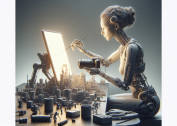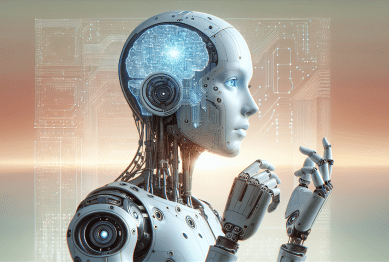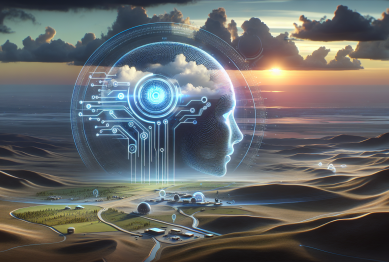Artificial intelligence is reshaping daily lives in profound ways. This engaging guide unravels how machine learning, automation, neural networks, and ethical debates shape the future of technology and science. Discover why growing demand for AI skills is driving global innovation—explore how these advancements may affect everyone.
The Basics of Artificial Intelligence Explained
Artificial intelligence (AI) sparks fascination around the world. It is the science of creating computer systems able to perform tasks that typically require human intelligence. Common examples include recognizing speech, translating languages, or identifying images. By using machine learning, computers uncover patterns in massive data sets to solve problems independently. Many devices and services already use forms of AI, making it essential to understand this multi-layered technology and how it influences tech and science.
Fundamental AI components combine algorithms, data, and computing power. Machine learning, a subset of AI, enables computers to learn by example instead of being programmed with fixed rules. This process involves training a model on specific data, allowing it to predict or decide outcomes in new situations. As a result, software can improve its own performance over time—think of how email spam filters evolve as they identify new threats. Such automation increases efficiency in apps, phone features, and even medical diagnostics.
Neural networks mimic the structure of the human brain, supporting complex tasks such as voice assistants or facial recognition. With multiple interconnected layers, these networks learn increasing details about a problem, from basic edges in a photo to identifying a face. Ultimately, modern AI solutions blend these approaches, harnessing big data and powerful computers to transform industries. Even mundane activities, like searching online or navigating with a smartphone, rely on AI beneath the surface. The basics of AI reveal why demand for knowledgeable tech professionals keeps growing.
Real World Applications That Shape Technology
AI applications are rapidly entering almost every sphere of life. In healthcare, AI-powered diagnostic tools analyze X-rays and medical records, assisting doctors with identifying patterns previously missed by the human eye (https://www.nibib.nih.gov/news-events/newsroom/ai-could-transform-health-care). In finance, fraud detection algorithms flag unusual transactions, boosting security. Autonomous vehicles, powered by layers of machine learning, aim to make roads safer by anticipating hazards faster than a person can react. Many industries are tapping into AI’s capabilities for innovation.
Speech recognition technology, a direct offshoot of AI research, enables virtual assistants like Siri or Alexa to answer questions and automate household routines. Retailers deploy recommendation engines to personalize shopping, suggesting items based on browsing habits. In scientific research, AI processes immense datasets—such as genomic information or astronomical images—enabling discoveries at a pace once unimaginable. These applications blend human expertise with computational power, revealing new levels of productivity and helping businesses adapt to constant technological change.
Robotics is another field embracing AI in manufacturing, logistics, and even agriculture. Automated warehouses equip robots with AI to efficiently pick, sort, and deliver orders. In agriculture, AI analyzes soil quality, crop health, and weather data to maximize yields sustainably (https://www.nifa.usda.gov/about-nifa/blogs/ai-agriculture). As more practical uses emerge, the interconnection between AI and everyday activities becomes strikingly clear. Innovations in AI are not just futuristic—they are visible in real time, shaping the world and creating widespread demand for tech-savvy problem-solvers.
Machine Learning and Deep Learning—A Closer Look
Machine learning lies at the heart of many AI systems. It allows software to evolve without explicit human-driven rules. Essentially, a machine is presented with large datasets (images, sounds, or text), learns from those examples, and predicts outputs for unseen data. For image classification, thousands of labeled photos help an AI learn what characterizes a dog or a tree. This learning cycle, known as training, tunes an algorithm’s strengths by maximizing accuracy. The field is booming, as demonstrated by the surge in data analytics jobs globally.
Deep learning takes machine learning further using artificial neural networks. These networks process information in layers, extracting ever more complex features as data passes through. Consider voice recognition: sound waves are transformed into text by deep neural networks trained on vast audio samples. Tools like image recognition, automated translation, or advanced search engines all deploy deep learning to improve performance. These complex systems enable smarter automation and uncover insights hidden in vast information streams, giving scientists and businesses new tools for discovery.
The growing demand for AI professionals reflects the importance of both machine learning and deep learning. Tech companies, healthcare organizations, and research institutes prioritize these skills in their workforce. As deep learning enables more realistic language models and smarter chatbots, the future looks bright for anyone interested in digital transformation. Understanding this landscape is critical for staying ahead in technology and science, as the ability to interpret, design, or manage machine learning tools is now among the most valued tech skills in major industries.
AI and Automation: Benefits and Considerations
Automation, powered by AI technologies, brings efficiency and accuracy to various industries. Automated systems handle repetitive tasks such as data entry, inventory tracking, and scheduling with reliability. In factories, robots assisted by AI monitor assembly lines and correct quality issues, reducing human error and enhancing output (https://www.nist.gov/news-events/news/2022/03/artificial-intelligence-automation-and-advanced-manufacturing). For professionals, this shift means more time for creativity and strategic decision-making. Automation is not limited to large organizations—small businesses and startups deploy AI-powered tools to streamline customer service and operations.
Yet, automation spurs debate about the future of work. While it opens new job opportunities in programming, analytics, and oversight, some routine jobs may be engineered out. Adaptability and continuous learning become crucial in such a changing landscape. Many experts emphasize digital skills training as a response—fueling growth in online courses, university programs, and hands-on workshops. These programs help people transition into new roles that involve designing, managing, or collaborating with AI systems, blending tech expertise with problem-solving and creativity.
The benefits of automation are clear in healthcare, logistics, and customer experiences that require swift, accurate responses. However, ethical considerations around privacy, fairness, and transparency grow as AI integrates more deeply into society. Responsible design—rooted in clear guidelines, unbiased data, and explainable algorithms—remains the foundation for trustworthy AI systems. Thoughtful adoption helps organizations and individuals leverage automation for prosperity, while maintaining safeguards for public trust and wellbeing.
Ethics, Challenges, and the Evolving Landscape
AI advancements raise vital questions around ethics and human values. Algorithms could reflect or amplify biases present in original data, impacting hiring, lending, or law enforcement outcomes (https://www.brookings.edu/articles/algorithmic-bias-detection-and-mitigation-best-practices-and-policies-to-reduce-consumer-harms). Ensuring fairness and equity means building transparency into AI models and actively monitoring for discrimination. Many organizations now assemble diverse teams to review AI systems and adopt principles for accountable technology development.
Privacy concerns are closely examined as AI collects and processes personal data for everything from personalized ads to smart home devices. Regulatory frameworks like GDPR in Europe or state policies in the U.S. lead the way in setting boundaries for data use (https://gdpr.eu/). Public trust in AI depends on transparency—people want to know how decisions are made and their personal data is handled. Privacy features, informed consent, and strong cybersecurity are vital for ongoing acceptance and safe innovation.
The future landscape of AI is shaped by continuous advances in technology, evolving business needs, and shifting societal priorities. Ongoing research explores explainable AI, adaptive learning, and collaborative human-machine partnerships. Thoughtful policies crafted by governments, industry groups, and research institutes help ensure safe, equitable, and beneficial AI outcomes for all. In such a dynamic space, lifelong learning, ethical reflection, and community engagement remain essential for harnessing AI’s full potential across science and technology.
Preparing for a Future Shaped by Artificial Intelligence
Preparing for a future where AI is ubiquitous requires more than just technical know-how. It calls for curiosity, adaptability, and a willingness to engage with new ideas and tools. For students and professionals, learning about AI’s foundational concepts is accessible through structured courses, research projects, and community workshops. Many universities, nonprofits, and major companies offer entry points for beginners and advanced learners alike, often free of charge (https://www.coursera.org/learn/ai-for-everyone). Understanding AI bridges gaps across engineering, healthcare, business, and education, unlocking career and innovation pathways.
Non-technical skills matter, too. Critical thinking, ethics, and communication help individuals navigate AI’s broader impact on society. Interdisciplinary cooperation—between computer scientists, artists, psychologists, and policy experts—encourages responsible innovation. As AI technologies shape global and local realities, integrating science and humanities perspectives fosters thoughtful, creative solutions that benefit diverse communities, not just tech companies or governments.
Staying up to date on AI trends may feel overwhelming, yet it is more manageable with the right resources. Reliable online platforms, research publications, and industry news offer continuous learning opportunities. By embracing both technical and ethical dimensions, anyone can participate in the evolution of technology and science. Artificial intelligence is not merely a distant prospect—it is a pivotal, dynamic force in everyone’s daily lives and shared future.
References
1. National Institute of Biomedical Imaging and Bioengineering. (n.d.). Artificial Intelligence Could Transform Health Care. Retrieved from https://www.nibib.nih.gov/news-events/newsroom/ai-could-transform-health-care
2. U.S. Department of Agriculture, National Institute of Food and Agriculture. (n.d.). Artificial Intelligence in Agriculture. Retrieved from https://www.nifa.usda.gov/about-nifa/blogs/ai-agriculture
3. National Institute of Standards and Technology. (2022). Artificial Intelligence, Automation, and Advanced Manufacturing. Retrieved from https://www.nist.gov/news-events/news/2022/03/artificial-intelligence-automation-and-advanced-manufacturing
4. Brookings Institution. (2019). Algorithmic bias detection and mitigation: Best practices and policies to reduce consumer harms. Retrieved from https://www.brookings.edu/articles/algorithmic-bias-detection-and-mitigation-best-practices-and-policies-to-reduce-consumer-harms
5. GDPR.eu. (n.d.). Complete guide to GDPR compliance. Retrieved from https://gdpr.eu/
6. Coursera. (n.d.). AI For Everyone. Retrieved from https://www.coursera.org/learn/ai-for-everyone









